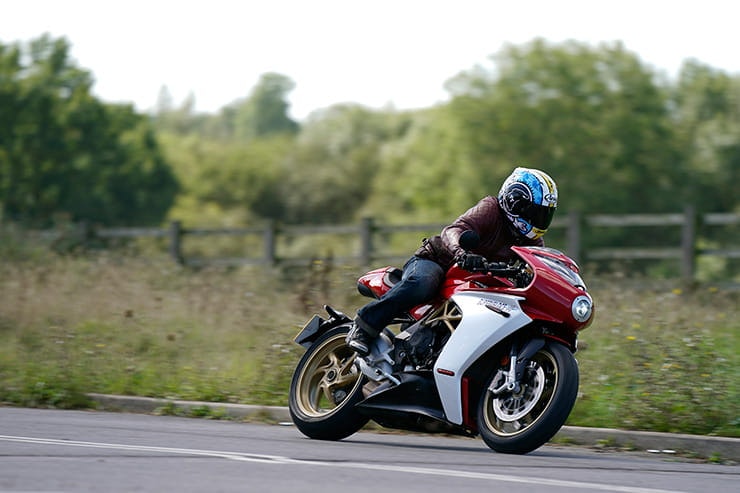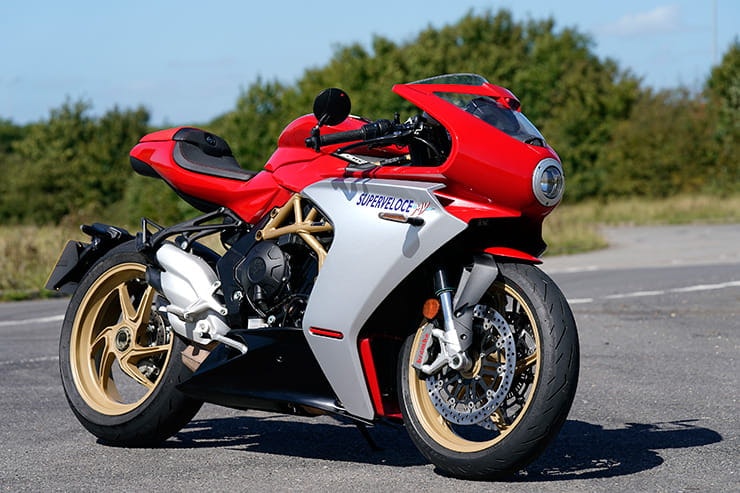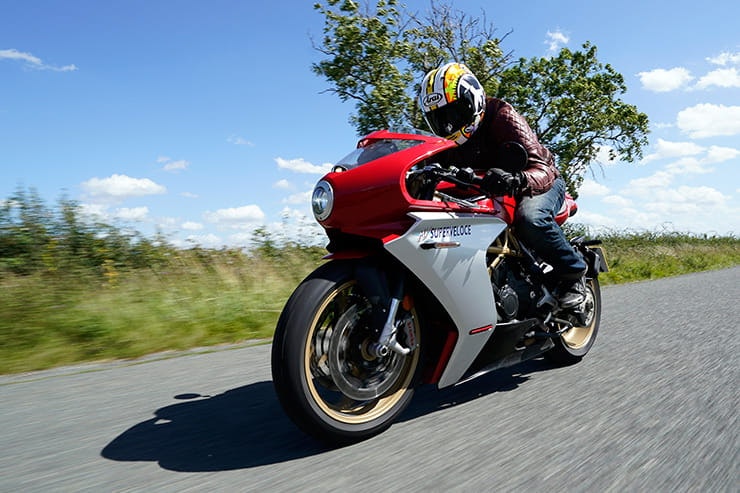MV Agusta Superveloce 800 (2020) – Review
BikeSocial Road Tester
08.09.2020
When MV Agusta first unveiled the Superveloce at EICMA in 2018, my jaw hit the floor. Now, on a perfect summer day in the UK, on the actual production bike, which isn’t too far removed from the beautiful prototype, I’m in love again. She is stunning. A simple question, is there a more desirable, sexier production bike on the market?
The Superveloce is unique, a throwback to the ’70s when MV dominated racing. It’s individual and daring. It’s built and manufactured in Italy, produced by an iconic manufacturer with an eye for detail. Check out the single LED headlight and taillight, the three protruding exhausts, the ‘dummy’ leather strap over the fuel tank, which is lavish, over the top and serves no purpose other than to catch the eye… MV has even hidden all the fairing fasteners and unsightly bolts to give the appearance that the sculpted 70’s bodywork is floating – and I love it.
Judged on looks alone it must be one of the highlights of this year, arguably the last five years. It’s based on the highly acclaimed, track-focused, if slightly dated F3, so it should perform, too. But does it go as well as it looks? A week in the UK racking up close to 800 miles should give us some answers.
Image, looks and exclusivity
Engine performance and sound
Sporty handling
Not comfortable, especially at low speeds
Firm suspension
Pillions will have to be brave
2020 MV Agusta Superveloce Price
As you’d expect from MV, and like anything attractive and high-maintenance from Italy, the new Superveloce is, at £17,390 in the UK for the base model, expensive. Ranked against the Honda Fireblade and Ducati V4 Panigale, both are priced around £20,000, that price doesn’t seem too extravagant but that’s not comparing eggs with eggs as the Superveloce is only 800cc in capacity and produces a relatively modest 148hp. Instead we should be looking at bikes like Ducati’s V2 Panigale, which makes similar power and costs £15,295, or Triumph’s limited edition Moto2 Daytona, now with a 765cc capacity, 128bhp and a price tag of £15,765. Even if MV look in their garage, the F3 800 that the Superveloce is based upon is £13,990.
Power and torque
Peak power and torque are identical to the MV F3, which was launched back in 2013 – yes, that long ago. Peak power is 108kw/148hp at 13,000rpm and peak torque is 88Nm/64.9lbft at 10,600rpm. The torque and power curves are identical between the two models, though the Superveloce has slightly different fuelling to compensate for the change in the air-box intake runners, which differ slightly from the F3.
In today’s world where super-naked and superbikes are producing 200bhp and more, the new MV may not have a power figure to impress your trackday-loving mates, but in on the road the power is impressive and usable. You don’t have to dance around on the gear selector in search of drive because the three-cylinder engine with its counter-rotating crank has usable power lower down in the rev range, then really starts to take off and run from the mid-range onwards. There are also four riding modes – Sport, Race, Rain and a Custom mode that changes the engine characteristics and throttle response.
Engine gearbox and exhaust
The three protruding silencers sound as good as they look. MV always produces a lovely sounding bike and the Superveloce continues that tradition. Despite passing Euro-4 regulations the 3-1-2 exhaust’s acoustic output gets better and better as you send the digital rev-counter towards its redline. At tick-over the MV hums mildly but still sounds unique. As the revs build so does its lung capacity, helping to make the MV one of those bikes you just love to rev, if only to hear the three exhausts holler.
On the road there’s no real need to go down the gearbox for an overtake and you don’t have to leave every 30mph zone in second gear either as there is more than enough torque on hand. But because it sounds so good you can’t help but go back a few gears and allow the engine scream. Shifts are effortless thanks to a super-smooth gearbox with an up and down quick-shifter. The auto-blipper matches the revs every time on rapid down changes, and the cut in power on up changes is like race bike – smooth and fast. Even at speeds as low as 30mph those clutchless changes are fuss-free. On occasion, I accidentally managed to find a neutral between 1st and 2nd but only a few times on an 800-mile test.
Once you get the triple spinning in the upper half of its rev range, the MV feels at its happiest and in its element. Make no mistake the Superveloce is a quick bike; it might look like a 1970s throwback but underneath there are still 148 angry Italian horses that want to run.
In first gear and occasionally in second gear the eight-stage traction control works overtime to keep the front wheel in contact with the ground. The counter-rotating crank, combined with a rider pushed forward, over the top yoke, means it’s not a wheelie happy bike – instead it just accelerates forward. However, if you do want to impress your mates it’s more than happy to loft the front (once you’ve deactivated the TC, which is easy to do and can be done on the move thanks to the easy-to-use full colour TFT clocks). The Superveloce may look like a work of art, but don’t be mistaken it’s still a 150mph sportsbike underneath that retro clothing. It’s like Hussain Bolt in a 1970s tracksuit.
Back in the real world, away from wheelies and top speed, MV has often been criticised for poor fuelling at low speeds. In Race mode, as you’d expect, it’s a little harsh, but in Sport and even more so in Rain mode is much softer and easy to use. Unfortunately, I had to ride through a biblical rainstorm with lots of standing water and was thankful for the soft Rain mode.
Economy
MV quote a consumption figure of 6.4 litres per 100km, which equates to a quoted 44.14mpg, and means in theory the 16.5l fuel tank should give a range of 194.2 miles until empty. On test, mpg varied depending on the conditions and riding, but averaged just under 40mpg, 39.4mpg to be precise, making the actual range is 174 miles. Realistically you need to think about searching for fuel at 125-130 mile mark.
Handling, suspension, chassis and weight
The suspension comprises fully-adjustable Marzocchi forks upfront, and a fully-adjustable single Sachs unit at the rear and is identical to that on MV’s F3. But for this year MV has added a new, progressive linkage on the rear and revised the forks’ settings. The overall set-up is, as you’d expect, on the sporty side but not overly harsh – this certainly isn’t a race bike for the road. But equally this isn’t a softly sprung sportsbike like the Triumph Dayton Moto2; it’s only friendly up to a point.
Like the engine, the faster you ride, the happier the suspension and handling is. It copes with braking, acceleration and cornering loads with ease. You could roll out onto a trackday with few complaints, the set-up is track-ready with standard tyres. The Superveloce feels completely at home on fast, smooth and flowing sections; at times I had to remind myself I wasn’t in race leathers and had to pull my knee in to avoid contact with the road.
On bumpier, uneven surfaces the MV doesn’t feel as accomplished. It’s stable, and not as harsh as MV’s new Brutale 1000RR, and again the faster you go, the more you load the suspension, the happier it feels. But on the odd occasion the rear did jolt my spine. If I lived somewhere remote, used more B-roads than As, I’d certainly think about opening up the suspension to make it plusher and more road focused.
Around town, while constantly admiring your reflection in shop windows, you will grimace from time to time. Potholes and speed humps aren’t your friends. The riding position is on the radical side and the seat isn’t soft enough – so don’t forget that black visor to mask your discomfort. But aside from posing why are you in town? Get away from the smoke, allow the MV to breathe, enjoy the sporty handling, and decide if it’s knee down or knee up.
2020 MV Agusta Superveloce Brakes
Like the suspension the Brembo radial stoppers are stolen from the F3, and are the same high quality set up. Without an IMU, which measures lean angle, adjustable ABS braking is conventional and not lean-sensitive. I never had a problem with conventional ABS but some owners may have expect cornering ABS on a premium 2020 model.
I rode the Superveloce in all conditions and was happy with the brake set up. In the wet, the Pirelli Rosso Corsa 2 tyres are much better than they appear, and the ABS isn’t too intrusive. In the dry, the brake lever has a nice progressive feel to it, the Marzocchi forks drive smoothly through their stroke, not too rapidly and rebound is controlled.
Rider aids and extra equipment/accessories
As mentioned, the new Superveloce doesn’t have an IMU and therefore the eight-stage traction control isn’t lean-sensitive. However, traction control intervention and reintervention are smooth and effortless. Furthermore, it is a doddle to change on the move. I was up to eight, the maximum setting, in the wet and deactivated the TC for the photoshoot.
The all-new full-colour 5in TFT clocks are easy to navigate and clear with simple graphics. It’s easy to change the TC on the move, even to de-activate it without stopping. And you don’t have to scroll through various screens and sub-menus as it’s simple and intuitive. I love the new clocks, and unlike the MV 1000 Brutale 1000RR, they are in the correct position behind the retro screen, not near the fuel cap. The new clocks allow Bluetooth connectivity and communication with the MV Ride App. Again, the app is simple and easy to use: you can track your ride, even change the settings like ABS and TC, from your phone.
The Superveloce may appear to be a 1970s throwback, but the new clocks give you the very latest technology. The only downside is they are hard to read when the sun is low and behind the rider. While the riding modes are easy to change via the start button, in low light it’s hard to read and Rain mode can look like Race mode – maybe they should have called them wet and track mode.
Cruise control comes as standard and, as mentioned, so does the up-and-down super smooth quick-shifter. Cruise control hints towards, dare I say, practicality, if you can say that about a retro MV with bar-end mirrors, which are surprisingly good.
As you’d expect there are some lovely accessories to play with – carbon trinkets especially – while the CNC aluminium spoked wheels are mouth-watering, and there’s an aftermarket Arrow race exhaust. This is for track use only and pushes power to 153hp and looks stunning with two pipes exiting on the right and one on the left. I’m told it sounds amazing.
Rivals
2020 MV Agusta Superveloce Verdict
In many ways we can simplify the new MV Superveloce. It’s essentially a highly acclaimed F3 with new clocks, stunning styling and revised suspension. Take one of the best-handling bikes in your range, if not in the middle-weight category, leave its brilliant inline triple alone, make it sound great and cover it in unique, inspiring bodywork and styling.
MV couldn’t go wrong really. I think it’s jaw-droppingly beautiful, and underneath is a motor and handling to match. This is a true retro racer that could embarrass dedicated sportsbikes on the track. It’s not the most comfortable, especially in town, the screen is too low on the motorway and pillions will have to be brave or stupid. If you can live with the discomfort and the price and, yes, MV dealers are sparse, then you’ll fall in love every time you open your garage and press the starter button.
2020 MV Agusta Superveloce Spec
What is MCIA Secured?
MCIA Secured gives bike buyers the chance to see just how much work a manufacturer has put into making their new investment as resistant to theft as possible.
As we all know, the more security you use, the less chance there is of your bike being stolen. In fact, based on research by Bennetts, using a disc lock makes your machine three times less likely to be stolen, while heavy duty kit can make it less likely to be stolen than a car. For reviews of the best security products, click here.
MCIA Secured gives motorcycles a rating out of five stars, based on the following being fitted to a new bike as standard:
A steering lock that meets the UNECE 62 standard
An ignition immobiliser system
A vehicle marking system
An alarm system
A vehicle tracking system with subscription
The higher the star rating, the better the security, so always ask your dealer what rating your bike has, and compare it to other machines on your shortlist.
Looking for motorcycle insurance? Get a quote for this motorbike with Bennetts bike insurance
Photography: Tim Keeton – impact images


